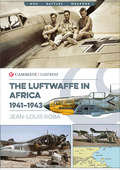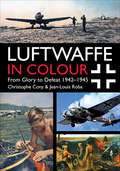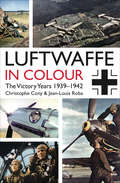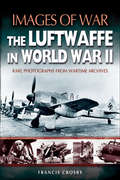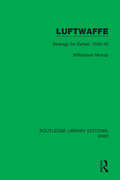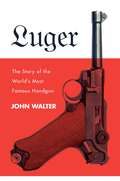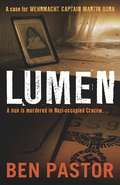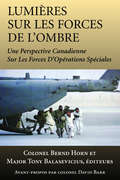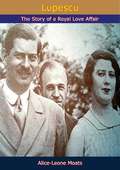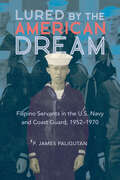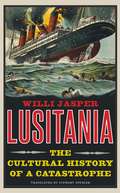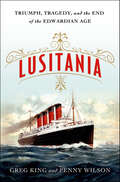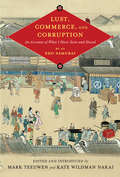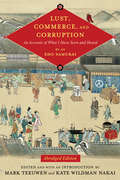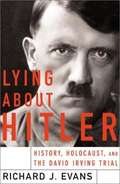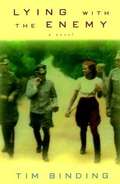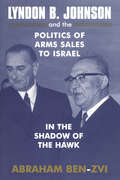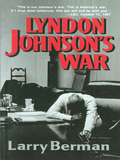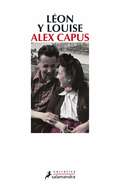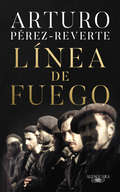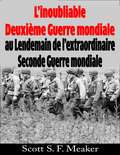- Table View
- List View
Luftwaffe in Africa, 1941–1943 (Casemate Illustrated #Cis0015)
by Jean-Louis RobaThis WWII history examines Nazi air force operations in Egypt and Libya with more than 100 rare wartime photographs. When Mussolini&’s army was defeated on the Libyan-Egyptian border at the beginning of 1941, Adolph Hitler had no choice but to send reinforcements to help his ally. The Luftwaffe deployed an air detachment, first to Sicily, then to North Africa. This volume examines the small expeditionary force, solely devoted to protecting Italian possessions in the Mediterranean and Middle Eastern theater. When General Erwin Rommel launched his Afrika Korps to the east, the Luftwaffe had to go on the offensive to cover the advance. As British air forces were strengthened, German High Command was obliged to send more aerial units into what it had initially considered a peripheral arena of the war. Losses in bombers and fighters were high on both sides. By the time the Allies landed in Morocco and Algeria at the end of 1942, the Wehrmacht&’s fate was sealed. The last German units capitulated in Tunisia in May 1943.
Luftwaffe in Colour: From Glory to Defeat
by Christophe Cony Jean-Louis RobaNearly four hundred photos documenting the last years of the Luftwaffe: &“If you&’re interested in unit history then this book is a must have&” (Britmodeller.com). A companion to the first volume of Luftwaffe in Colour, which covered the victory years from 1939 to Spring 1942, this book contains even more fascinating material on the machines of the Luftwaffe and the men who flew them as their fate took an increasingly grim path. Initially, the Luftwaffe ruled the skies, but eventually, they fought an increasingly futile war of attrition that, when combined with vital strategic mistakes in aircraft production, was its death knell. Despite this, the Luftwaffe produced the most successful air aces of all time. Among many remarkable images, we see one of the last Junkers 87 B-2 operational on the Eastern Front during the winter of 1942-1943; the huge BV 222 V-5 of Lufttransportstaffel in the port of Heraklion in late 1942; pilots in Tunisia in 1943; the aces Hans Philipp, Wolfgang Späte, and Heinz Schnaufer; and a vivid demonstration of the reversal in fortunes in 1944 as Allied bombers destroy 106 sites, engulfing them in fire at Schwäbisch Hall on German soil. In this painstakingly curated collection, the full detail behind the propaganda is once more revealed in rare color photographs.
Luftwaffe in Colour: The Victory Years
by Christophe Cony Jean-Louis RobaA photo-packed look at the men and machines of one of history&’s legendary air forces. This remarkable work explores the Luftwaffe as it truly existed day-to-day, underneath the propaganda of their own regime and the stories of their enemies. In Hitler&’s Germany, color photography was primarily co-opted for state purposes, such as the military publication Signal or the Luftwaffe&’s own magazine, Der Adler. But a number of men had cameras of their own, and in this painstakingly acquired collection, we can witness true life on Germany&’s airfields during the period of the Luftwaffe&’s ascendancy. Not only do we see famous planes such as the Me-109, Ju-87, and He-111, but the wide variety of more obscure types with which the Germans began the war. The array of Arados, Dorniers, Heinkels—not to mention elegant four-engine Condors—that were initially employed in the war are here in plain sight and full color, providing not only an insight into WWII history but a model maker&’s dream. Just as fascinating are the shots of the airmen themselves, along with their ground crews—full of confidence and cheer as they bested every other air force in Europe during these years, with the single exception of the RAF&’s Fighter Command in late summer 1940. But that was no big stumbling block to the Luftwaffe, which had bigger fish to fry in Russia and North Africa the following year. &“Both volumes [The Victory Years and From Glory to Defeat] are a fantastic addition to your aviation library. The reproduction quality is superb.&” —War History Online
Luftwaffe in World War II (Images Of War Bks.)
by Francis CrosbyWorld War Two Luftwaffe aircraft and their pilots have been a source of fascination and respect to aviation buffs since 1945. This book looks at all aspects of its operation in many World War II theaters. A great majority of photographs are unlikely to have been seen by the general public and they have been superbly reproduced directly from original negatives held by the Imperial War Museum.Lengthy captions describe the action portrayed in each photo and an introduction puts the Luftwaffe into its historical perspective.
Luftwaffe: Strategy for Defeat, 1933–45 (Routledge Library Editions: WW2 #16)
by Williamson MurrayThis book, first published in 1985, is an in-depth analysis of the Luftwaffe in the Second World War, using previously untapped German archives and newly-released ‘Ultra’ intelligence records. It looks at the Luftwaffe within the context of the overall political decision-making process within the Third Reich. It is especially valuable for its careful study of industrial production and pilot losses in the conduct of operations.
Luger: The Story of the World's Most Famous Handgun
by Walter JohnThe distinctive look of the Luger and its role in German military history make it the world’s most famous handgun. In Luger, renowned gun expert John Walter traces the history of this semiautomatic pistol from an early design by Hugo Borchardt in the 1890s through its use in the trenches of the First World War to the final days of the Third Reich in WWII. Other books on the Parabellum-Pistole, as the Luger was also known, focus strictly on narrow subjects like manufacturing details or accessories. While still offering the technical details to satisfy the collector, Walter provides a comprehensive narrative history. Readers will learn of the initial collaboration between Borchardt and Georg J. Luger, who patented the design in 1898. Following initial adoption by the Swiss Army, design refinements convinced the Imperial German Navy to order the sidearm, while the US Army passed on it following field trials in favor of the Colt. Production ramped up for World War I and the gun became a prized trophy for Allied soldiers in both that conflict and World War II. (German soldiers, aware of their desirability, even used them as bait for booby traps.) Today, it is still desired by collectors both for its unique design and for its connection to the history of Nazi Germany, and Luger: The Story of the World’s Most Famous Handgun tells how it came to be.
Luke Air Force Base (Images of America)
by Rick GrisetLuke Air Force Base, created in less than a year from desert scrub and farmland, stands some 20 miles west of Phoenix. On March 31, 1941, months before the United States entered World War II, construction began. That summer, the Army Air Corps named Luke Field after World War I hero and triple ace Frank Luke Jr. Some pilots from Luke Field's first class flew from airfields in Hawaii during the Japanese attack on Pearl Harbor. From the beginning, Luke Field trained fighter pilots, as it does today. Over the years, Luke Air Force Base was home to 14 primary fighter aircraft, graduated over 60,000 students, and accounted for millions of training flight hours. Of the pilots who trained at Luke Field, a number became aces, including the all-time US leading ace, Maj. Richard I. Bong. For decades, Luke Air Force Base has been home to more fighter aircraft than any other base in the United States, earning the moniker "Fighter Country."
Lumen
by Ben PastorEqual parts wartime political intrigue, detective story, psychological thriller and religious mystery, Pastor's debut follows a German army captain and a Chicago priest as they investigate the death of a nun in Nazi-occupied Poland. Stunned by the violence of the occupation and by the ideology of his colleagues, Bora's sense of Prussian duty is tested to the breaking point.
Lumières sur les forces de l'ombre
by Colonel Bernd Horn Tony Balasevicius Colonel David BarrLes Forces d’opérations spéciales (SOF) n’ont jamais fait partie intégrante des capacités militaires du Canada. Des unités spéciales ont certes existé à certaines périodes de notre histoire, mais elles ont toujours oeuvré dans l’ombre, à la limite de la reconnaissance. Elles ont presque toujours ete marginalisées. Cependant, la tragique attaque lancée par des terroristes sur les tours jumelles du World Trade Center à New York, le 11 septembre 2001, a considérablement modifié leur image. Les SOF sont devenues depuis des forces de premier plan. Les éssais qui forment cet ouvrage concernant les SOF ont été redigés par des experts en la matière. Pris collectivement, ils constituent un recueil exhaustif d’informations et de connaissances sur les SOF canadiennes et sur des questions et sujets qui s’y rapportent. En somme, l’ouvrage permet au lecteur d’acquérir une solide base sur la théorie, le contexte historique et l’évolution des SOF, y compris les événements qui favorisent leur expansion.
Luna Marine
by Ian DouglasThe revelations on Mars -- a half-million year-old legacy of the vanished star-traveling Builders -- have fed the flames of catastrophic war. A beleaguered United States and its Russian and Japanese allies struggle to hold their own against the indomitable forces of the enemy United Nations. The bloody conflict that has swept over the home planet now rages across the blackness of space -- with the U.S. Marine Corps in the vanguard, leading the charge as always.But Mars is not the sole repository of alien wonders. The Earth's moon hides unsettling mysteries of its own-and dangerous secrets pointing toward an unstoppable threat advancing from somewhere beyond the solar system. And as scientists on both sides ract to utilize technology they have only barely begun to comprehend, the UN makes the opening move in a gambit that could end the hostilities quickly and decisively by bringing about the death of millions...without the aid of alien-inspired weaponry.A bad situation worsens by the nanosecond. And that means it's time to call in the Marines -- to make a life or death stand on the gray shores of Luna.
Lupescu: The Story of a Royal Love Affair
by Alice-Leone MoatsIn 2003, the coffins of King Carol II and Princess Elena of Romania were repatriated to their native Romania from the resting place in exile in Portugal. This book recounts the story of Magda Lupescu, the red haired courtesan, who would become the wife of King Carol and future princess of Romania. Their affair had rocked the monarchy and all of Europe after the tumult of the First World War. The reign of King Carol was mired in intrigue and subterfuge amid the right wing surge in Germany and Central Europe, he was forced to abdicate and flee as the Second World War began. Elena and Carol travelled to South America in exile, before returning to Europe and settling in Portugal after World War Two ended.
Lured by the American Dream: Filipino Servants in the U.S. Navy and Coast Guard, 1952-1970 (Asian American Experience)
by P. James PaligutanStarting in 1952, the United States Navy and Coast Guard actively recruited Filipino men to serve as stewards--domestic servants for officers. Oral histories and detailed archival research inform P. James Paligutan's story of the critical role played by Filipino sailors in putting an end to race-based military policies. Constrained by systemic exploitation, Filipino stewards responded with direct complaints to flag officers and chaplains, rating transfer requests that flooded the bureaucracy, and refusals to work. Their actions had a decisive impact on seagoing military’s elimination of the antiquated steward position. Paligutan looks at these Filipino sailors as agents of change while examining the military system through the lens of white supremacy, racist perceptions of Asian males, and the motives of Filipinos who joined the armed forces of the power that had colonized their nation. Insightful and dramatic, Lured by the American Dream is the untold story of how Filipino servicepersons overcame tradition and hierarchy in their quest for dignity.
Lusitania: The Cultural History of a Catastrophe
by Willi Jasper Mr Stewart SpencerA fascinating reassessment of a turning point in the First World War, revealing its role in shaping the German psyche On May 7, 1915, the Lusitania, a large British luxury liner, was sunk by a German submarine off the Irish coast. Nearly 1,200 people, including 128 American citizens, lost their lives. The sinking of a civilian passenger vessel without warning was a scandal of international scale and helped precipitate the United States' decision to enter the conflict. It also led to the immediate vilification of Germany. Though the ship's sinking has preoccupied historians and the general public for over a century, until now the German side of the story has been largely untold. Drawing on varied German sources, historian Willi Jasper provides a comprehensive reappraisal of the sinking and its aftermath that focuses on the German reaction and psyche. The attack on the Lusitania, he argues, was not simply an escalation of violence but signaled a new ideological, moral, and religious dimension in the struggle between German Kultur and Western civilization.
Lusitania: Triumph, Tragedy, and the End of the Edwardian Age
by Greg King Penny WilsonOn the 100th Anniversary of its sinking, King and Wilson tell the story of the Lusitania's glamorous passengers and the torpedo that ended an era and prompted the US entry into World War I.Lusitania: She was a ship of dreams, carrying millionaires and aristocrats, actresses and impresarios, writers and suffragettes – a microcosm of the last years of the waning Edwardian Era and the coming influences of the Twentieth Century. When she left New York on her final voyage, she sailed from the New World to the Old; yet an encounter with the machinery of the New World, in the form of a primitive German U-Boat, sent her – and her gilded passengers – to their tragic deaths and opened up a new era of indiscriminate warfare.A hundred years after her sinking, Lusitania remains an evocative ship of mystery. Was she carrying munitions that exploded? Did Winston Churchill engineer a conspiracy that doomed the liner? Lost amid these tangled skeins is the romantic, vibrant, and finally heartrending tale of the passengers who sailed aboard her. Lives, relationships, and marriages ended in the icy waters off the Irish Sea; those who survived were left haunted and plagued with guilt.Authors Greg King and Penny Wilson resurrect this lost, glittering world to show the golden age of travel and illuminate the most prominent of Lusitania's passengers. Rarely was an era so glamorous; rarely was a ship so magnificent; and rarely was the human element of tragedy so quickly lost to diplomatic maneuvers and militaristic threats.
Lust, Commerce, and Corruption: An Account of What I Have Seen and Heard, by an Edo Samurai (Translations from the Asian Classics)
by Anne Walthall Kate Wildman Nakai John Breen Trans. Eds. Teeuwen Mark Fumiko UmezawaBy 1816, Japan had recovered from the famines of the 1780s and moved beyond the political reforms of the 1790s. Despite persistent economic and social stresses, the country seemed to be approaching a new period of growth. The idea that the shogunate would not last forever was far from anyone's mind.Yet, in that year, an anonymous samurai author completed one of the most detailed critiques of Edo society known today. Writing as Buyo Inshi, "a retired gentleman of Edo," he expresses a profound despair with the state of the realm and with people's behavior and attitudes. He sees decay wherever he turns and believes the world will soon descend into war.Buyo shows a familiarity with many corners of Edo life that one might not expect in a samurai. He describes the corruption of samurai officials; the suffering of the poor in villages and cities; the operation of brothels; the dealings of blind moneylenders; the selling and buying of temple abbotships; and the dubious strategies townspeople use in the law courts. Perhaps the frankness of his account, which contains a wealth of concrete information about Edo society, made him prefer to remain anonymous.This volume contains a full translation of Buyo's often-quoted but rarely studied work by a team of specialists on Edo society. Together with extensive annotation of the translation, the volume includes an introduction that situates the text culturally and historically.
Lust, Commerce, and Corruption: An Account of What I Have Seen and Heard, by an Edo Samurai, Abridged Edition (Translations from the Asian Classics)
by Kate Wildman Nakai Mark TeeuwenBy 1816, Japan had recovered from the famines of the 1780s and moved beyond the political reforms of the 1790s. Despite persistent economic and social stresses, the country seemed headed for a new period of growth. The idea that the shogunate would not last forever was far from anyone's mind.Yet, in that year, an anonymous samurai produced a scathing critique of Edo society. Writing as Buyo Inshi, "a retired gentleman of Edo," he expressed in An Account of What I Have Seen and Heard a profound despair with the state of the realm. Seeing decay wherever he turned, Buyo feared the world would soon descend into war.In his anecdotes, Buyo shows a sometimes surprising familiarity with the shadier aspects of Edo life. He speaks of the corruption of samurai officials; the suffering of the poor in villages and cities; the operation of brothels; the dealings of blind moneylenders; the selling and buying of temple abbotships; and the dubious strategies seen in law courts. Perhaps it was the frankness of his account that made him prefer to stay anonymous.A team of Edo specialists undertook the original translation of Buyo's work. This abridged edition streamlines this translation for classroom use, preserving the scope and emphasis of Buyo's argument while eliminating repetitions and diversions. It also retains the introductory essay that situates the work within Edo society and history.
Luxury Fleet: The Imperial German Navy 1888-1918
by Holger HerwigThis book reviews the building of the German Imperial navy from a small coastal defense fleet to the world's second largest navy by the First World War. The term "Luxury Fleet" (as coined by Winston Churchill) denotes British view of the German navy as a luxury while the British navy was vital to its existence. This dichotomy is detailed in the monograph and the rivalries that ensued.
Lying About Hitler: History, Holocaust and the David Irving Trial
by Richard J. EvansTo those who argue that the London court's 2000 ruling against Holocaust denier Irving threatens to silence legitimate historians' questions on the Nazi extermination of Jews, the Cambridge U. specialist on modern German history who was the principal expert witness for the defense (of Deborah Lipstadt for libel) says, in effect, rubbish. Evans explains how Irving's "analysis" distorts the historical record to serve his revisionist agenda.
Lying with the Enemy
by Tim BindingIn 1943, 145,000 Germans had been slaughtered in Stalingrad. The tide of the war was beginning to turn. But not on the quiet, idyllic island of Guernsey, the only British territory to be occupied by German troops in the Second World War. Here Nazi officers still party with local girls, love affairs blossom, and the amateur dramatic society continues to stage its theatricals, if with suspiciously jackbooted pirates in Peter Pan. Then the body of a young woman, her nose and mouth filled with cement, turns up, and the comedy of manners played out by the collaborators and their captors turns sour. Food becomes scarce, facades of civility crack, the skies over Guernsey darken, and the search for a killer unearths horrors shared by the islanders and the enemy alike.
Lyndon B. Johnson and the Politics of Arms Sales to Israel: In the Shadow of the Hawk (Israeli History, Politics And Society Ser.)
by Abraham Ben-ZviLyndon B. Johnson and the Politics of Arms Sales to Israel seeks to reconstruct and elucidate the processes behind the decisions made by the Johnson Administration during the years 1965-68 to sell Israel M-48 tanks, A-4 Skyhawk planes and F-4 Phantom planes. This examination is based on a distinction between three factions which competed for influe
Lyndon Johnson's War: The Road to Stalemate in Vietnam
by Larry Berman"Stunning....The portrait of the embattled and unyielding president that emerges is vivid and memorable."--Publishers Weekly By 1968, the United States had committed over 525,000 men to Vietnam and bombed virtually all military targets recommended by the joint Chiefs of Staff. Yet, the United States was no closer to securing its objectives than it had been prior to the Americanization of the war. The long-promised light at the end of the tunnel was a mirage. This absorbing account reveals the bankruptcy of the bombing campaign against North Vietnam, the failures of political reform in South Vietnam and the bitter bureaucratic conflicts between the US government and its military commanders.
Lágrimas del sol naciente dorado: perspectiva de testigo ocular en la historia de Biafra
by Ikechukwu JosephPero Emily se despertó en una granja abandonada. Parecía más somnolienta y adormilada. Ella no podía reconocerse a sí misma. Todo lo que podía escuchar eran los cantos de las ranas toro y la correspondiente respuesta más ligera de su contraparte femenina. Sándwich en el medio estaban las bocinas de vehículos distantes. Emily se durmió de nuevo como un tronco. El sueño era tan dulce ahora. El sedante no solo indujo el sueño, sino que también tuvo un efecto calmante y calmante. Ya estaba amaneciendo con adoradores del sol y pájaros del sol haciendo lo suyo cuando la pobre Emily se despertó. Todavía estaba cansada y aturdida. "¡Hola! ¡Hola! ¿Hay alguien ahí?" Trató de levantarse pero sus manos y piernas estaban atadas a la silla. Aterrada, gritó, pero nadie pudo oírla. Al mirar por la ventana vio un sedán rojo aparcado en lo que parecía la parte trasera del corral. Emily luchó por liberarse, pero estaba muy débil. El efecto de los sedantes. Miró a su alrededor y vio una pistola a un lado de la habitación. Ha pasado mucho tiempo que vio uno desde que escapó de la zona de guerra. Su fuerte voluntad luchó contra el pánico en su voz. "Bebé, ¿estás despierto?" Una voz ronca se acercó por detrás y tocó su cuello, masajeando. Emily se estremeció al recordar todas las historias tanto de MM como de las novelas. El violador en serie, los secuestradores y ritualista. "¿Pero qué hice?" Miró al anciano con cabello gris y ojos llameantes. "Bebé, tienes que comer para tener fuerzas para luchar contra tus enemigos ..." Cuando Angelo abrió una de las pilas de bolsas, algo que parecía un hueso humano se cayó. Lo besó y se rió histéricamente murmurando palabras como "su carne era muy dulce, dulce señora, su esposo debe haberte extrañado. Espero que Dios me dé otro como tú que rompa la regla número uno". Entonces Emily se dio cuenta de que había sido presa de un caníbal humano. Rezó todas las oraciones, pero parecía no tener
Léon y Louise
by Alex CapusExquisita por su ligereza y conmovedora por su intensidad, la verosimilitud del relato sorprenderá al lector más avezado. Obra finalista del Deutscher Buchpreis -uno de los premios literarios de referencia en Alemania-, esta última novela de Alex Capus es la máxima expresión de una historia de amor que desafía todas las convenciones. El verano de 1918, la Primera Guerra Mundial está a punto de terminar, pero sus consecuencias perdurarán durante décadas. Para algunas personas, incluso toda una vida. Léon le Gall es un joven rebelde de apenas diecisiete años que ha decidido dejar los estudios y trabaja como ayudante en la estación ferroviaria de Saint-Luc-sur-Marne, en la costa de Normandía. Allí es donde conoce a la hermosa y esquiva Louise Janvier, y entre ellos surge un sentimiento puro, noble y profundo. Sin embargo, todo salta por los aires cuando Louise desaparece durante un bombardeo de la aviación alemana. Abatido porla pérdida, Léon logra reconstruir su vida. Se casa, tiene hijos y empieza a trabajar como científico para la policía, pero nunca conseguirá olvidar a Louise. La crítica ha dicho...«Entre todas las parejas de enamorados, felices o infelices, que nos ha presentado la literatura, la de Léon y Louise es una de las más originales y creíbles.»Süddeutsche Zeitung «El libro de esta primavera. Una historia maravillosa que deja un vacío cuando uno termina de leerla. Y que nos hace desear secretamente encontrar a alguien como Léon en la próxima vida. O a alguien como Louise.»WDR «La historia de un amor que se opone a la historia del mundo. Una pieza literaria finamente trabajada sobre el deseo de lograr la felicidad, sobre la conformidad y la supervivencia.»Tages-Anzeiger «Este libro elige a sus lectores. [...] Alex Capus ha escrito una fascinante historia de amor en circunstancias difíciles [...]. Una historia bellísima que lo es tanto por su estilo como por todo aquello que el lenguaje no puede describir.»Frankfurter Allgemeine Zeitung «A simple vista, ésta es una historia de un amor que perdura. Pero también habla de los abusos de poder, especialmente en tiempos de guerra, y de los sacrificios que el ser humano debe hacer para preservar aquello que más ama.»Publishers Weekly
Línea de fuego
by Arturo Pérez-ReverteLA NUEVA NOVELA DE ARTURO PÉREZ-REVERTE Julio de 1938, miles de jóvenes combaten en la trágica batalla del Ebro. Sus nombres no son los que recuerda la Historia, pero cuanto les sucedió forma parte de nuestra memoria. «Es lo malo de estas guerras. Que oyes al enemigo llamar a su madre en el mismo idioma que tú.» Durante la noche del 24 al 25 de julio de 1938, la XI Brigada Mixta del ejército de la República cruza el río para establecer una cabeza de puente en Castellets del Segre. En las inmediaciones del pueblo, medio batallón de infantería, un tabor marroquí y una compañía de la Legión defienden la zona. Está a punto de comenzar la batalla del Ebro, la máscruda y sangrienta que se libró nunca en suelo español. Combinando de forma magistral la ficción con datos históricos y testimonios personales, Arturo Pérez-Reverte sitúa al lector, con sobrecogedor realismo, entre quienes, voluntarios o a la fuerza, lucharon en los frentes de batalla de la Guerra Civil. Sus nombres no son los que recuerda la Historia, pero cuanto les sucedió resuena en estas páginas con el dramatismo de una memoria que nos pertenece a todos. Ésta no es una novela sobre la Guerra Civil, sino sobre los hombres y mujeres que combatieron en ella. La historia de los padres y abuelos de numerosos españoles de hoy. La crítica ha dicho:«La novela definitiva sobre la Guerra Civil española. [Un] proyecto literario inmenso, envolvente y, pese a la crudeza del relato, poderosamente fascinante por la trascendencia del momento en que nos sumerge.»Sergio Vila-Sanjuán, Cultura/s, La Vanguardia «Un libro asombroso, durísimo y brillante. Todo está ahí, todo en esas páginas escritas con un pulso y una habilidad endiabladas. Un libro para leer, para meditar y al que hay que volver. Línea de fuego es una obra maestra, una catedral literaria y la mejor novela de Arturo Pérez-Reverte.»Juan Gómez-Jurado, El Correo «La batalla del Ebro fue emblemática [...]. Allí ha recalado Pérez-Reverte con la cámara de sus ojos y calidad de su escritura para decirnos que el horror y la piedad, la sinrazón y el heroísmo no son ideas, son vida y cuerpos, que necesitaban de un gran novelista que supiera contarlos.»José María Pozuelo Yvancos, ABCultural «Un relato épico del mejor novelista de nuestro tiempo.»Raúl del Pozo, El Mundo «680 páginas hipnóticas, intensas en emoción y humanidad.»Javier Ors, La Razón «Hay mucha más verdad histórica en Línea de fuego que en la Historia que nos quieren contar los políticos.»Julia Navarro «No va a dejar a nadie indiferente. Sabe de lo que habla, y ha sabido contarlo.»Jesús García Calero, ABC «Una novela de madurez sobre el desconcierto, el desamparo y el miedo.»Antonio Lucas, El Mundo «Línea de fuego, en fin, es una gran novela, muy española, justo cuando ya no sabemos qué es lo español.»Alberto Olmos, El Confidencial «Inmensa, estremecedora e imprescindible. Una obra que se asoma y se adentra hasta el corazón de la peor tragedia vivida en los últimos siglos por nuestra patria y nuestras gentes. [...] Una novela de hueso y carne viva. Sin grasa. Es un Arturo Pérez Reverte en su más espléndida madurez literaria despojada más todavía que nunca de condicionantes.»Antonio Pérez Henares, El Día de Valladolid «Pérez-Reverte nos regala una obra maestra que se adentra en la Guerra Civil española [...] para darnos una quintaesencia no solo del choque sino del alma fratricida de todala
L’inoubliable Deuxième Guerre mondiale: au Lendemain de l’extraordinaire Seconde Guerre mondiale
by Hanène Baatout Scott S. F. Meaker*** Ceci est un petit ouvrage qui se focalise sur le lendemain de l'extraordinaire Seconde Guerre mondiale *** La guerre a la tradition de changer la carte sociale et économique d'un pays. Le concept de famille a été complètement déchiré avec la dévastation généralisée de la Seconde Guerre mondiale. Ce livre se penche sur les expériences de six personnes provenant de divers secteurs impliqués dans ce conflit mondial - à la suite de l'extraordinaire Seconde Guerre mondiale.
